The robot builds itself as easily as building blocks
What, robots have evolved to the point where they can build themselves? !
Researchers at the Massachusetts Institute of Technology (MIT) were so imaginative that they came up with this scene:
Robot No. 1 was busy picking out parts and assembling something. .
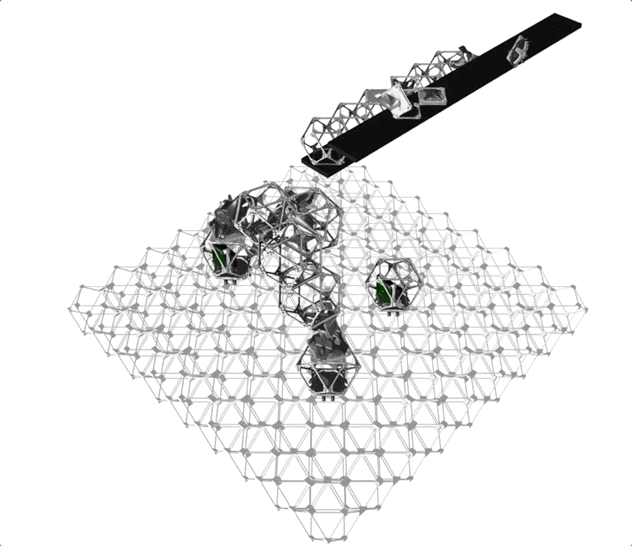
#After a while, the identical Robot No. 2 was born on the spot!
It's not over yet - Robot No. 2 just came into this world, and it immediately became as agile as No. 1. Then it "put on" two accessories for itself, oh no, accessories.
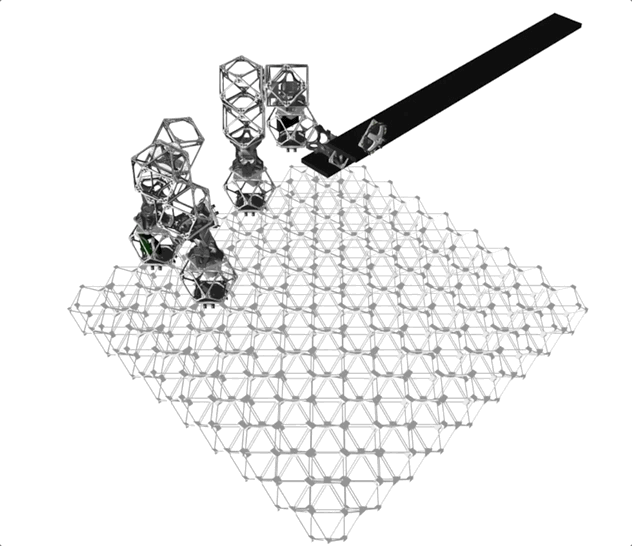
#Emm... It seems that the robot "matryoshka doll" has really come into reality now.

MIT researchers pointed out:
In addition to cloning itself, this kind of robot can also build larger robots in layers.
According to this idea, when building large buildings or large mechanical equipment in the future, it may be possible to construct small modules step by step like building blocks, without having to build a giant machine tool next to it.
This can greatly improve construction efficiency!
Relevant research papers have been published in the Nature sub-journal Communications Engineering.

Mainly due to the "intelligent" module
It is not difficult to see from the previous animation that this kind of robot can clone itself so quickly, mainly Thanks to its piecemeal "parts," researchers call it Voxel.
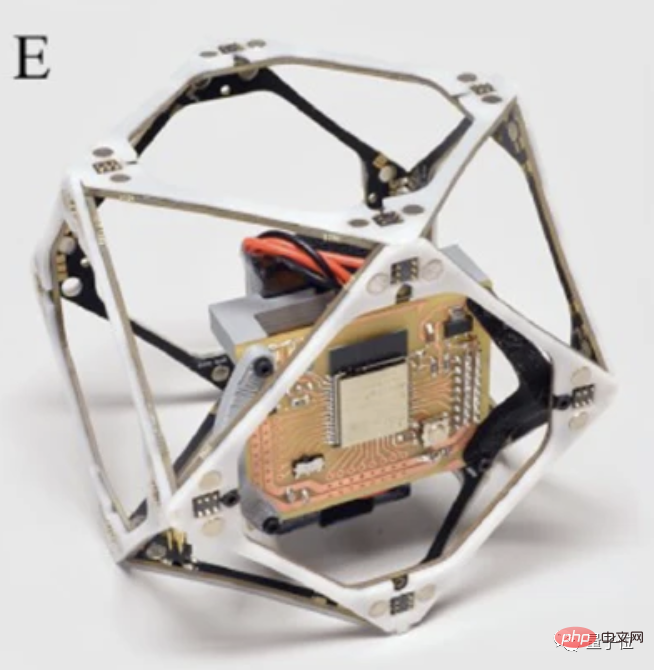
#The word Voxel is the abbreviation of Volume Pixel. We can simply understand it as a module.
As for why the module grows like this, researchers say that the inspiration comes from the crystal lattice, which is the spatial structure in which atoms are regularly arranged in a crystal. The cuboctahedral structure has the advantages of low density and high stiffness, and is also easy to assemble and disassemble.
Previous modules were basically purely mechanical, and in addition to mechanical structures, these modules also have intelligent control systems.
The module is equipped with a battery, central processor, actuator, etc. in the middle, allowing it to move flexibly and navigate independently.
There are many electromagnets on the edge of the module, so that two adjacent modules can be firmly connected. Each set of face-to-face connections can transmit 8A current and 50N tensile force at 10V voltage.
But movement alone is not enough. The process of robots selecting parts and building new robots also involves grabbing actions.
So the research team also designed a "wrist" for the robot.
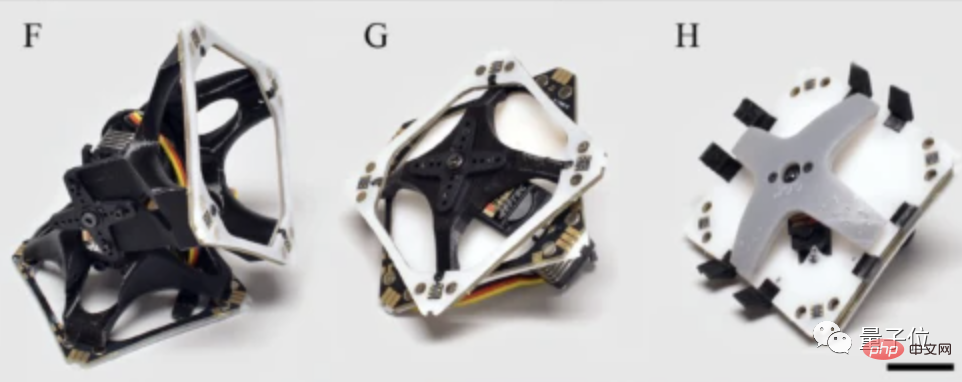
This "joint" is more flexible than other modules, making it easier for the robot to "pick up" parts and build them in layers.
At this point, there is still a question: How to grab the correct modules and spell out the desired new structure in order?
First, the robot's computing system will automatically discretize the input geometry into multiple ordered hierarchical building blocks through a compiler based on the given target shape.
Then, the system will also analyze the best assembly sequence to improve efficiency and prevent confusion in the "building block" process.
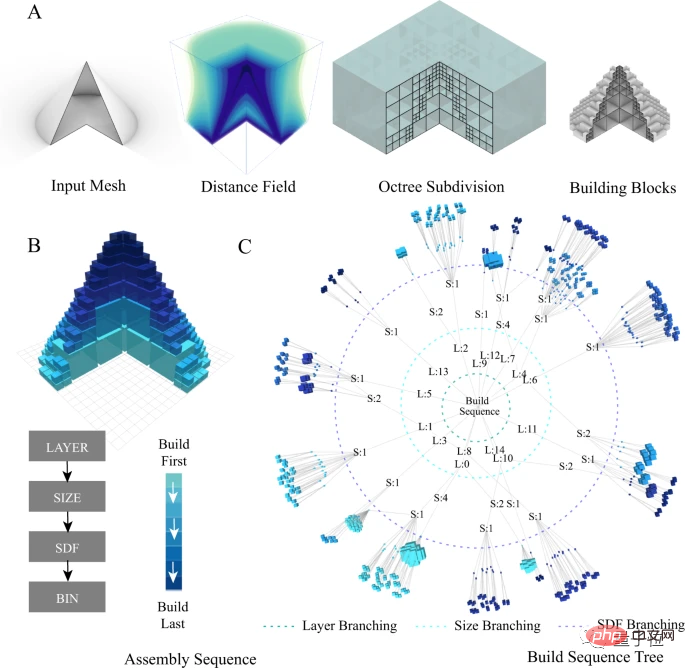
Next, the robot can clone itself in an orderly manner, and even build a larger robot.
However, the researchers also pointed out that during the actual operation, they found that the components were not flexible enough (the animation at the beginning is what it looks like in a simulation environment), and they are currently researching and developing more powerful and sensitive connectors.

Researcher Profile
The researcher comes from MIT's Center for Bit and Atomic Research and the U.S. Army Research Laboratory.
Amira Abdel-Rahman, the first author and corresponding author of the paper, is currently a doctoral candidate at MIT and holds a master's degree in technical design research from Harvard University.

Her main research direction is to use computers to analyze manufacturing processes and manufacturing systems.
In addition, the designer of the overall concept of the system is Professor Neil Gershenfeld, who is currently the director of the MIT Center for Bit and Atomic Research. He is also a member of the American Physical Society.

Currently, the MIT Center for Bits and Atoms Research is working to break the boundaries between computer science and classical physics, and explore how to better combine data and hardware.
Paper address: https://www.nature.com/articles/s44172-022-00034-3
Reference link: https://techcrunch.com/2022/11/22 /researchers-are-building-robots-that-can-build-themselves/
The above is the detailed content of The robot builds itself as easily as building blocks. For more information, please follow other related articles on the PHP Chinese website!

Hot AI Tools

Undresser.AI Undress
AI-powered app for creating realistic nude photos

AI Clothes Remover
Online AI tool for removing clothes from photos.

Undress AI Tool
Undress images for free

Clothoff.io
AI clothes remover

AI Hentai Generator
Generate AI Hentai for free.

Hot Article

Hot Tools

Notepad++7.3.1
Easy-to-use and free code editor

SublimeText3 Chinese version
Chinese version, very easy to use

Zend Studio 13.0.1
Powerful PHP integrated development environment

Dreamweaver CS6
Visual web development tools

SublimeText3 Mac version
God-level code editing software (SublimeText3)

Hot Topics
 1386
1386
 52
52
 The second generation Ameca is here! He can communicate with the audience fluently, his facial expressions are more realistic, and he can speak dozens of languages.
Mar 04, 2024 am 09:10 AM
The second generation Ameca is here! He can communicate with the audience fluently, his facial expressions are more realistic, and he can speak dozens of languages.
Mar 04, 2024 am 09:10 AM
The humanoid robot Ameca has been upgraded to the second generation! Recently, at the World Mobile Communications Conference MWC2024, the world's most advanced robot Ameca appeared again. Around the venue, Ameca attracted a large number of spectators. With the blessing of GPT-4, Ameca can respond to various problems in real time. "Let's have a dance." When asked if she had emotions, Ameca responded with a series of facial expressions that looked very lifelike. Just a few days ago, EngineeredArts, the British robotics company behind Ameca, just demonstrated the team’s latest development results. In the video, the robot Ameca has visual capabilities and can see and describe the entire room and specific objects. The most amazing thing is that she can also
 How can AI make robots more autonomous and adaptable?
Jun 03, 2024 pm 07:18 PM
How can AI make robots more autonomous and adaptable?
Jun 03, 2024 pm 07:18 PM
In the field of industrial automation technology, there are two recent hot spots that are difficult to ignore: artificial intelligence (AI) and Nvidia. Don’t change the meaning of the original content, fine-tune the content, rewrite the content, don’t continue: “Not only that, the two are closely related, because Nvidia is expanding beyond just its original graphics processing units (GPUs). The technology extends to the field of digital twins and is closely connected to emerging AI technologies. "Recently, NVIDIA has reached cooperation with many industrial companies, including leading industrial automation companies such as Aveva, Rockwell Automation, Siemens and Schneider Electric, as well as Teradyne Robotics and its MiR and Universal Robots companies. Recently,Nvidiahascoll
 After 2 months, the humanoid robot Walker S can fold clothes
Apr 03, 2024 am 08:01 AM
After 2 months, the humanoid robot Walker S can fold clothes
Apr 03, 2024 am 08:01 AM
Editor of Machine Power Report: Wu Xin The domestic version of the humanoid robot + large model team completed the operation task of complex flexible materials such as folding clothes for the first time. With the unveiling of Figure01, which integrates OpenAI's multi-modal large model, the related progress of domestic peers has been attracting attention. Just yesterday, UBTECH, China's "number one humanoid robot stock", released the first demo of the humanoid robot WalkerS that is deeply integrated with Baidu Wenxin's large model, showing some interesting new features. Now, WalkerS, blessed by Baidu Wenxin’s large model capabilities, looks like this. Like Figure01, WalkerS does not move around, but stands behind a desk to complete a series of tasks. It can follow human commands and fold clothes
 The first robot to autonomously complete human tasks appears, with five fingers that are flexible and fast, and large models support virtual space training
Mar 11, 2024 pm 12:10 PM
The first robot to autonomously complete human tasks appears, with five fingers that are flexible and fast, and large models support virtual space training
Mar 11, 2024 pm 12:10 PM
This week, FigureAI, a robotics company invested by OpenAI, Microsoft, Bezos, and Nvidia, announced that it has received nearly $700 million in financing and plans to develop a humanoid robot that can walk independently within the next year. And Tesla’s Optimus Prime has repeatedly received good news. No one doubts that this year will be the year when humanoid robots explode. SanctuaryAI, a Canadian-based robotics company, recently released a new humanoid robot, Phoenix. Officials claim that it can complete many tasks autonomously at the same speed as humans. Pheonix, the world's first robot that can autonomously complete tasks at human speeds, can gently grab, move and elegantly place each object to its left and right sides. It can autonomously identify objects
 How to convert a virtual machine to a physical machine?
Feb 19, 2024 am 11:40 AM
How to convert a virtual machine to a physical machine?
Feb 19, 2024 am 11:40 AM
Converting a virtual machine (VM) to a physical machine is the process of migrating a virtual instance and associated application software to a physical hardware platform. This conversion helps optimize operating system performance and hardware resource utilization. This article aims to provide an in-depth look at how to make this conversion. How to implement migration from virtual machine to physical machine? Typically, the conversion process between a virtual machine and a physical machine is performed outside the virtual machine by third-party software. This process consists of multiple stages involving the configuration of virtual machines and the transfer of resources. Prepare the physical machine: The first step is to ensure that the physical machine meets the hardware requirements for Windows. We need to back up the data on a physical machine as the conversion process will overwrite the existing data. *Username and password for an administrator account with administrator rights to create system images. will be virtual
 The humanoid robot can do magic, let the Spring Festival Gala program team find out more
Feb 04, 2024 am 09:03 AM
The humanoid robot can do magic, let the Spring Festival Gala program team find out more
Feb 04, 2024 am 09:03 AM
In the blink of an eye, robots have learned to do magic? It was seen that it first picked up the water spoon on the table and proved to the audience that there was nothing in it... Then it put the egg-like object in its hand, then put the water spoon back on the table and started to "cast a spell"... …Just when it picked up the water spoon again, a miracle happened. The egg that was originally put in disappeared, and the thing that jumped out turned into a basketball... Let’s look at the continuous actions again: △ This animation shows a set of actions at 2x speed, and it flows smoothly. Only by watching the video repeatedly at 0.5x speed can it be understood. Finally, I discovered the clues: if my hand speed were faster, I might be able to hide it from the enemy. Some netizens lamented that the robot’s magic skills were even higher than their own: Mag was the one who performed this magic for us.
 Ten humanoid robots shaping the future
Mar 22, 2024 pm 08:51 PM
Ten humanoid robots shaping the future
Mar 22, 2024 pm 08:51 PM
The following 10 humanoid robots are shaping our future: 1. ASIMO: Developed by Honda, ASIMO is one of the most well-known humanoid robots. Standing 4 feet tall and weighing 119 pounds, ASIMO is equipped with advanced sensors and artificial intelligence capabilities that allow it to navigate complex environments and interact with humans. ASIMO's versatility makes it suitable for a variety of tasks, from assisting people with disabilities to delivering presentations at events. 2. Pepper: Created by Softbank Robotics, Pepper aims to be a social companion for humans. With its expressive face and ability to recognize emotions, Pepper can participate in conversations, help in retail settings, and even provide educational support. Pepper's
 Cloud Whale Xiaoyao 001 sweeping and mopping robot has a 'brain'! | Experience
Apr 26, 2024 pm 04:22 PM
Cloud Whale Xiaoyao 001 sweeping and mopping robot has a 'brain'! | Experience
Apr 26, 2024 pm 04:22 PM
Sweeping and mopping robots are one of the most popular smart home appliances among consumers in recent years. The convenience of operation it brings, or even the need for no operation, allows lazy people to free their hands, allowing consumers to "liberate" from daily housework and spend more time on the things they like. Improved quality of life in disguised form. Riding on this craze, almost all home appliance brands on the market are making their own sweeping and mopping robots, making the entire sweeping and mopping robot market very lively. However, the rapid expansion of the market will inevitably bring about a hidden danger: many manufacturers will use the tactics of sea of machines to quickly occupy more market share, resulting in many new products without any upgrade points. It is also said that they are "matryoshka" models. Not an exaggeration. However, not all sweeping and mopping robots are




